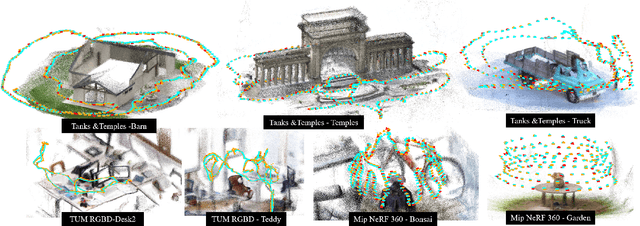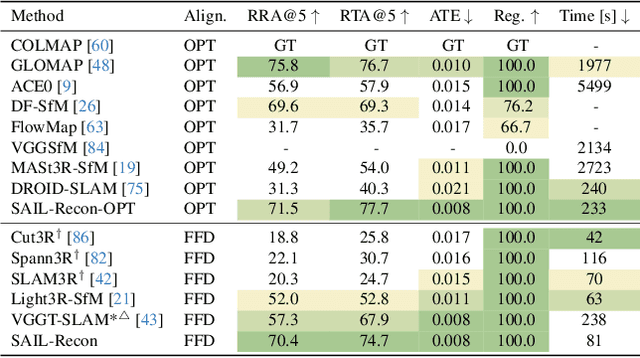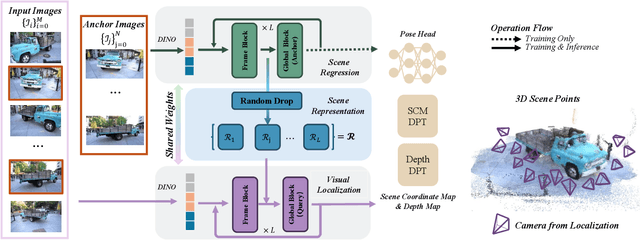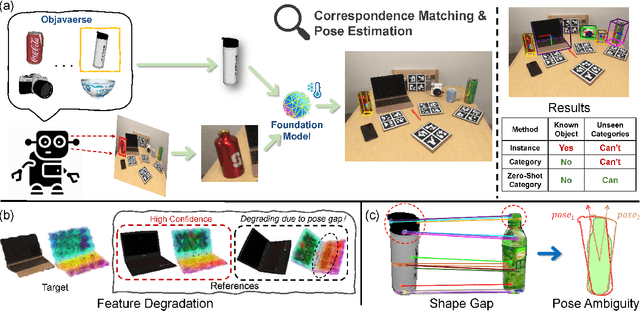Ping Tan
Simon Fraser University
SPATIALGEN: Layout-guided 3D Indoor Scene Generation
Sep 18, 2025Abstract:Creating high-fidelity 3D models of indoor environments is essential for applications in design, virtual reality, and robotics. However, manual 3D modeling remains time-consuming and labor-intensive. While recent advances in generative AI have enabled automated scene synthesis, existing methods often face challenges in balancing visual quality, diversity, semantic consistency, and user control. A major bottleneck is the lack of a large-scale, high-quality dataset tailored to this task. To address this gap, we introduce a comprehensive synthetic dataset, featuring 12,328 structured annotated scenes with 57,440 rooms, and 4.7M photorealistic 2D renderings. Leveraging this dataset, we present SpatialGen, a novel multi-view multi-modal diffusion model that generates realistic and semantically consistent 3D indoor scenes. Given a 3D layout and a reference image (derived from a text prompt), our model synthesizes appearance (color image), geometry (scene coordinate map), and semantic (semantic segmentation map) from arbitrary viewpoints, while preserving spatial consistency across modalities. SpatialGen consistently generates superior results to previous methods in our experiments. We are open-sourcing our data and models to empower the community and advance the field of indoor scene understanding and generation.
SAIL-Recon: Large SfM by Augmenting Scene Regression with Localization
Aug 25, 2025



Abstract:Scene regression methods, such as VGGT, solve the Structure-from-Motion (SfM) problem by directly regressing camera poses and 3D scene structures from input images. They demonstrate impressive performance in handling images under extreme viewpoint changes. However, these methods struggle to handle a large number of input images. To address this problem, we introduce SAIL-Recon, a feed-forward Transformer for large scale SfM, by augmenting the scene regression network with visual localization capabilities. Specifically, our method first computes a neural scene representation from a subset of anchor images. The regression network is then fine-tuned to reconstruct all input images conditioned on this neural scene representation. Comprehensive experiments show that our method not only scales efficiently to large-scale scenes, but also achieves state-of-the-art results on both camera pose estimation and novel view synthesis benchmarks, including TUM-RGBD, CO3Dv2, and Tanks & Temples. We will publish our model and code. Code and models are publicly available at: https://hkust-sail.github.io/ sail-recon/.
MGVQ: Could VQ-VAE Beat VAE? A Generalizable Tokenizer with Multi-group Quantization
Jul 10, 2025



Abstract:Vector Quantized Variational Autoencoders (VQ-VAEs) are fundamental models that compress continuous visual data into discrete tokens. Existing methods have tried to improve the quantization strategy for better reconstruction quality, however, there still exists a large gap between VQ-VAEs and VAEs. To narrow this gap, we propose \NickName, a novel method to augment the representation capability of discrete codebooks, facilitating easier optimization for codebooks and minimizing information loss, thereby enhancing reconstruction quality. Specifically, we propose to retain the latent dimension to preserve encoded features and incorporate a set of sub-codebooks for quantization. Furthermore, we construct comprehensive zero-shot benchmarks featuring resolutions of 512p and 2k to evaluate the reconstruction performance of existing methods rigorously. \NickName~achieves the \textbf{state-of-the-art performance on both ImageNet and $8$ zero-shot benchmarks} across all VQ-VAEs. Notably, compared with SD-VAE, we outperform them on ImageNet significantly, with rFID $\textbf{0.49}$ v.s. $\textbf{0.91}$, and achieve superior PSNR on all zero-shot benchmarks. These results highlight the superiority of \NickName~in reconstruction and pave the way for preserving fidelity in HD image processing tasks. Code will be publicly available at https://github.com/MKJia/MGVQ.
SpatialLM: Training Large Language Models for Structured Indoor Modeling
Jun 09, 2025Abstract:SpatialLM is a large language model designed to process 3D point cloud data and generate structured 3D scene understanding outputs. These outputs include architectural elements like walls, doors, windows, and oriented object boxes with their semantic categories. Unlike previous methods which exploit task-specific network designs, our model adheres to the standard multimodal LLM architecture and is fine-tuned directly from open-source LLMs. To train SpatialLM, we collect a large-scale, high-quality synthetic dataset consisting of the point clouds of 12,328 indoor scenes (54,778 rooms) with ground-truth 3D annotations, and conduct a careful study on various modeling and training decisions. On public benchmarks, our model gives state-of-the-art performance in layout estimation and competitive results in 3D object detection. With that, we show a feasible path for enhancing the spatial understanding capabilities of modern LLMs for applications in augmented reality, embodied robotics, and more.
UniTEX: Universal High Fidelity Generative Texturing for 3D Shapes
May 29, 2025Abstract:We present UniTEX, a novel two-stage 3D texture generation framework to create high-quality, consistent textures for 3D assets. Existing approaches predominantly rely on UV-based inpainting to refine textures after reprojecting the generated multi-view images onto the 3D shapes, which introduces challenges related to topological ambiguity. To address this, we propose to bypass the limitations of UV mapping by operating directly in a unified 3D functional space. Specifically, we first propose that lifts texture generation into 3D space via Texture Functions (TFs)--a continuous, volumetric representation that maps any 3D point to a texture value based solely on surface proximity, independent of mesh topology. Then, we propose to predict these TFs directly from images and geometry inputs using a transformer-based Large Texturing Model (LTM). To further enhance texture quality and leverage powerful 2D priors, we develop an advanced LoRA-based strategy for efficiently adapting large-scale Diffusion Transformers (DiTs) for high-quality multi-view texture synthesis as our first stage. Extensive experiments demonstrate that UniTEX achieves superior visual quality and texture integrity compared to existing approaches, offering a generalizable and scalable solution for automated 3D texture generation. Code will available in: https://github.com/YixunLiang/UniTEX.
PacTure: Efficient PBR Texture Generation on Packed Views with Visual Autoregressive Models
May 28, 2025Abstract:We present PacTure, a novel framework for generating physically-based rendering (PBR) material textures from an untextured 3D mesh, a text description, and an optional image prompt. Early 2D generation-based texturing approaches generate textures sequentially from different views, resulting in long inference times and globally inconsistent textures. More recent approaches adopt multi-view generation with cross-view attention to enhance global consistency, which, however, limits the resolution for each view. In response to these weaknesses, we first introduce view packing, a novel technique that significantly increases the effective resolution for each view during multi-view generation without imposing additional inference cost, by formulating the arrangement of multi-view maps as a 2D rectangle bin packing problem. In contrast to UV mapping, it preserves the spatial proximity essential for image generation and maintains full compatibility with current 2D generative models. To further reduce the inference cost, we enable fine-grained control and multi-domain generation within the next-scale prediction autoregressive framework to create an efficient multi-view multi-domain generative backbone. Extensive experiments show that PacTure outperforms state-of-the-art methods in both quality of generated PBR textures and efficiency in training and inference.
Step1X-3D: Towards High-Fidelity and Controllable Generation of Textured 3D Assets
May 12, 2025Abstract:While generative artificial intelligence has advanced significantly across text, image, audio, and video domains, 3D generation remains comparatively underdeveloped due to fundamental challenges such as data scarcity, algorithmic limitations, and ecosystem fragmentation. To this end, we present Step1X-3D, an open framework addressing these challenges through: (1) a rigorous data curation pipeline processing >5M assets to create a 2M high-quality dataset with standardized geometric and textural properties; (2) a two-stage 3D-native architecture combining a hybrid VAE-DiT geometry generator with an diffusion-based texture synthesis module; and (3) the full open-source release of models, training code, and adaptation modules. For geometry generation, the hybrid VAE-DiT component produces TSDF representations by employing perceiver-based latent encoding with sharp edge sampling for detail preservation. The diffusion-based texture synthesis module then ensures cross-view consistency through geometric conditioning and latent-space synchronization. Benchmark results demonstrate state-of-the-art performance that exceeds existing open-source methods, while also achieving competitive quality with proprietary solutions. Notably, the framework uniquely bridges the 2D and 3D generation paradigms by supporting direct transfer of 2D control techniques~(e.g., LoRA) to 3D synthesis. By simultaneously advancing data quality, algorithmic fidelity, and reproducibility, Step1X-3D aims to establish new standards for open research in controllable 3D asset generation.
SkillMimic-V2: Learning Robust and Generalizable Interaction Skills from Sparse and Noisy Demonstrations
May 04, 2025Abstract:We address a fundamental challenge in Reinforcement Learning from Interaction Demonstration (RLID): demonstration noise and coverage limitations. While existing data collection approaches provide valuable interaction demonstrations, they often yield sparse, disconnected, and noisy trajectories that fail to capture the full spectrum of possible skill variations and transitions. Our key insight is that despite noisy and sparse demonstrations, there exist infinite physically feasible trajectories that naturally bridge between demonstrated skills or emerge from their neighboring states, forming a continuous space of possible skill variations and transitions. Building upon this insight, we present two data augmentation techniques: a Stitched Trajectory Graph (STG) that discovers potential transitions between demonstration skills, and a State Transition Field (STF) that establishes unique connections for arbitrary states within the demonstration neighborhood. To enable effective RLID with augmented data, we develop an Adaptive Trajectory Sampling (ATS) strategy for dynamic curriculum generation and a historical encoding mechanism for memory-dependent skill learning. Our approach enables robust skill acquisition that significantly generalizes beyond the reference demonstrations. Extensive experiments across diverse interaction tasks demonstrate substantial improvements over state-of-the-art methods in terms of convergence stability, generalization capability, and recovery robustness.
GaussianAvatar-Editor: Photorealistic Animatable Gaussian Head Avatar Editor
Jan 17, 2025Abstract:We introduce GaussianAvatar-Editor, an innovative framework for text-driven editing of animatable Gaussian head avatars that can be fully controlled in expression, pose, and viewpoint. Unlike static 3D Gaussian editing, editing animatable 4D Gaussian avatars presents challenges related to motion occlusion and spatial-temporal inconsistency. To address these issues, we propose the Weighted Alpha Blending Equation (WABE). This function enhances the blending weight of visible Gaussians while suppressing the influence on non-visible Gaussians, effectively handling motion occlusion during editing. Furthermore, to improve editing quality and ensure 4D consistency, we incorporate conditional adversarial learning into the editing process. This strategy helps to refine the edited results and maintain consistency throughout the animation. By integrating these methods, our GaussianAvatar-Editor achieves photorealistic and consistent results in animatable 4D Gaussian editing. We conduct comprehensive experiments across various subjects to validate the effectiveness of our proposed techniques, which demonstrates the superiority of our approach over existing methods. More results and code are available at: [Project Link](https://xiangyueliu.github.io/GaussianAvatar-Editor/).
Universal Features Guided Zero-Shot Category-Level Object Pose Estimation
Jan 06, 2025



Abstract:Object pose estimation, crucial in computer vision and robotics applications, faces challenges with the diversity of unseen categories. We propose a zero-shot method to achieve category-level 6-DOF object pose estimation, which exploits both 2D and 3D universal features of input RGB-D image to establish semantic similarity-based correspondences and can be extended to unseen categories without additional model fine-tuning. Our method begins with combining efficient 2D universal features to find sparse correspondences between intra-category objects and gets initial coarse pose. To handle the correspondence degradation of 2D universal features if the pose deviates much from the target pose, we use an iterative strategy to optimize the pose. Subsequently, to resolve pose ambiguities due to shape differences between intra-category objects, the coarse pose is refined by optimizing with dense alignment constraint of 3D universal features. Our method outperforms previous methods on the REAL275 and Wild6D benchmarks for unseen categories.
 Add to Chrome
Add to Chrome Add to Firefox
Add to Firefox Add to Edge
Add to Edge